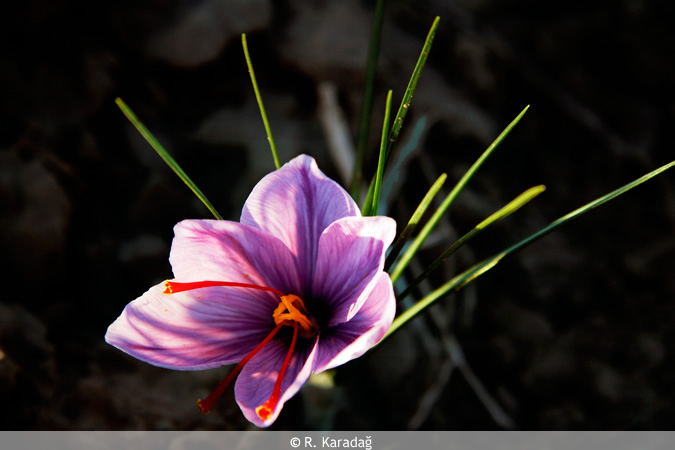Saffron is a crocus that blooms in the autumn with violet-blue petals and a long, orange-red, three-lipped stigma (the tip of the pistil). Asia Minor is probably the original home of saffron. Through cultivation, however, in antiquity it soon spread to Persia and farther eastward. The Arabs brought saffron via Moorish Spain to Europe ; the crusaders brought it directly from the Orient. Today, saffron is still cultivated in Morocco , Spain , Switzerland , Iran and Kashmir . In 1977, a little was still being cultivated near the Turkish town of Safranbolu , whose magnificent wooden houses still reflect the prosperity that saffron's cultivation and trade once brought. Saffron thrives at altitudes above 3,300 feet and requires fertile soil.Historical Data
Saffron has been cultivated in Asia Minor for 3,000 years, not just as a dye plant, but rather primarily for use as a spice and in medicines and perfumes. Saffron was cultivated in the Mediterranean region and in parts of Europe. It was mentioned that the foreign name saffron is derived from an Arabic word zaffran. Saffron is an ancient dye as it was known and cultivated for dyeing in ancient periods. Pliny mentioned that it was used in Ancient Palestine in dyeing of textiles. It has been identified in textile from the Bar Kochbah findings in the Judean Desert. However saffron according to Forbes was not produced in ancient Palestine but was grown in neighboring Syria, Jordan and Egypt. Saffron is mentioned frequently in Greek and Roman literature as well as in the Biblical Songs of Solomon. It was the principal yellow dyestuff used by Greeks and Romans.The Greeks considered it to be not only an important dyestuff, but also a colour for royalty. In the past, saffron was very important because it produces an excellent substantive dye, needing no mordant to produce its full color. Saffron was much esteemed in ancient Persia, where documents and the robes of emperors were dyed with it. Also it is mentioned that saffron was used in dyeing of Ottoman carpets dated back to 16 th Century. The Phrygians, early inhabitants of the region, dressed themselves in saffron-yellow robes. The robes of the Persian kings were dyed with saffron. The Romans used it as a spice to perfume the cushions before banquets and added it to the wine under the impression that it would protect from drunkenness. They considered saffron in the province of Cihcia in Southern Anatolia to be the best. According to Tavernier, saffron from Tokat in Central Anatolia was exported as far as India .The Berbers in the Atlas Mountains in Morocco still serve important guests peppermint tea flavored with saffron. In the literature, saffron-yellow robes are often mentioned, but this most probably is used as a comparison: yellow with saffron-yellow. The Buddhist monks in Asia do not dye their robes with saffron, but with the yellow wood of the jacktree (Artocarpus heterophyllus). The stigmata of the flowers. Before sunrise, the flowers are gathered and dried briefly, then the stigmata are removed from the style of the pistil. Just these provide the spice and the dyestuffs. They are dried and so can be kept almost indefinitely. For a pound of saffron, the stigmata of 40,000 to 90,000 flowers are needed. The price of saffron is almost the same as that of gold.

